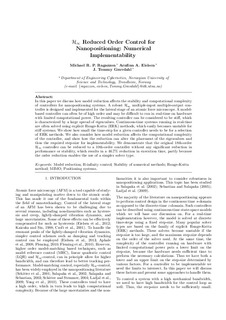| dc.contributor.author | Ragazzon, Michael Remo Palmén | |
| dc.contributor.author | Eielsen, Arnfinn Aas | |
| dc.contributor.author | Gravdahl, Jan Tommy | |
| dc.date.accessioned | 2015-01-19T13:24:10Z | |
| dc.date.accessioned | 2015-07-22T12:04:12Z | |
| dc.date.available | 2015-01-19T13:24:10Z | |
| dc.date.available | 2015-07-22T12:04:12Z | |
| dc.date.issued | 2014 | |
| dc.identifier.citation | Elsevier IFAC Publications / IFAC Proceedings series 2014 | nb_NO |
| dc.identifier.issn | 1474-6670 | |
| dc.identifier.uri | http://hdl.handle.net/11250/293450 | |
| dc.description | - Author's postprint | nb_NO |
| dc.description.abstract | In this paper we discuss how model reduction affects the stability and computational complexity of controllers for nanopositioning systems. A robust H∞ multiple-input multiple-output controller is designed and implemented for the lateral stage of an atomic force microscope. A model-based controller can often be of high order and may be difficult to run in real-time on hardware with limited computational power. The resulting controller can be considered to be stiff, which is characterized by a large spread of eigenvalues. Continuous-time systems running in real-time are often solved using explicit Runge-Kutta (ERK) methods, which easily becomes unstable for stiff systems. We show how small the time-step for a given controller needs to be for a selection of ERK methods. We also consider how model reduction affects the computational complexity of the controller, and show how the reduction can alter the placement of the eigenvalues and thus the required step-size for implementability. We demonstrate that the original 18th-order H∞ controller can be reduced to a 10th-order controller without any significant reduction in performance or stability, which results in a 46.7% reduction in execution time, partly because the order reduction enables the use of a simpler solver type. | nb_NO |
| dc.language.iso | eng | nb_NO |
| dc.publisher | Elsevier IFAC Publications | nb_NO |
| dc.relation.ispartofseries | IFAC Proceedings series; | |
| dc.rights | NOTICE: this is the author’s version of a work that was accepted for publication in Elsevier IFAC Publications Changes resulting from the publishing process, such as peer review, editing, corrections, structural formatting, and other quality control mechanisms may not be reflected in this document. Changes may have been made to this work since it was submitted for publication. A definitive version was subsequently published in Elsevier IFAC Publications / IFAC Proceedings series 2014 s. 6862-6869 DOI: 10.3182/20140824-6-ZA-1003.00501 | |
| dc.subject | Micro and Nano Mechatronic Systems; Identification and control methods; Vibration control | nb_NO |
| dc.title | H_inf Reduced Order Control for Nanopositioning: Numerical Implementability | nb_NO |
| dc.type | Journal article | nb_NO |
| dc.type | Peer reviewed | en_GB |
| dc.date.updated | 2015-01-19T13:24:10Z | |
| dc.rights.holder | Elsevier IFAC Publications | |
| dc.source.pagenumber | 6862-6869 | nb_NO |
| dc.source.volume | 19 | nb_NO |
| dc.source.issue | 1 | nb_NO |
| dc.identifier.doi | 10.3182/20140824-6-ZA-1003.00501 | |
| dc.identifier.cristin | 1154443 | |
| dc.relation.project | Norges forskningsråd: 192427 | nb_NO |
| dc.description.localcode | NOTICE: this is the author’s version of a work that was accepted for publication in Elsevier IFAC Publications Changes resulting from the publishing process, such as peer review, editing, corrections, structural formatting, and other quality control mechanisms may not be reflected in this document. Changes may have been made to this work since it was submitted for publication. A definitive version was subsequently published in Elsevier IFAC Publications / IFAC Proceedings series 2014 s. 6862-6869 DOI: 10.3182/20140824-6-ZA-1003.00501 | |
